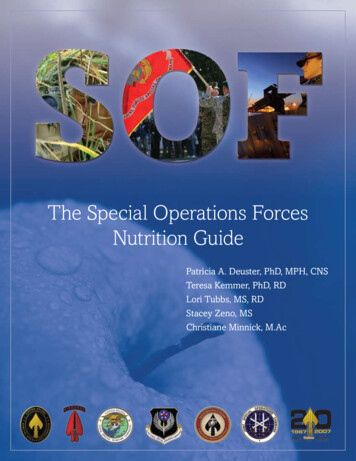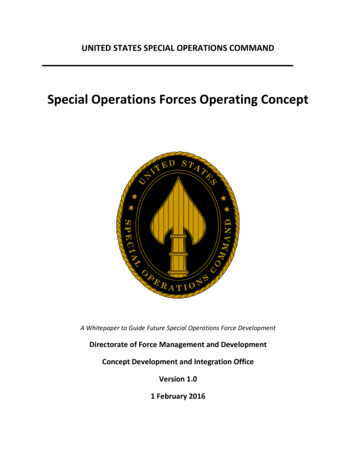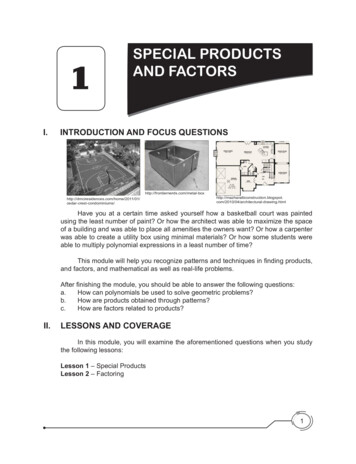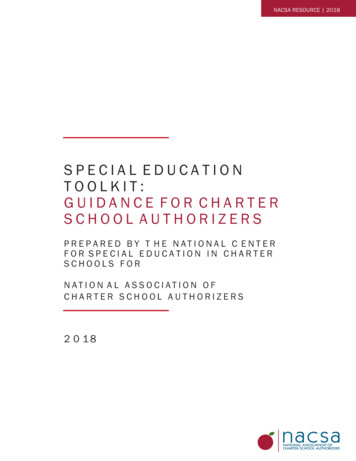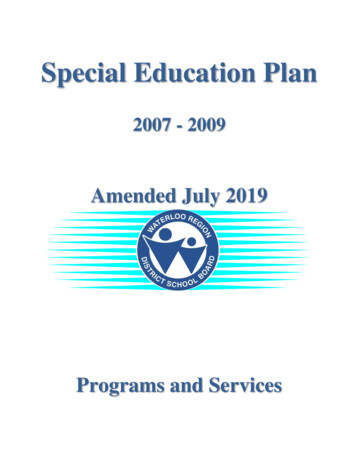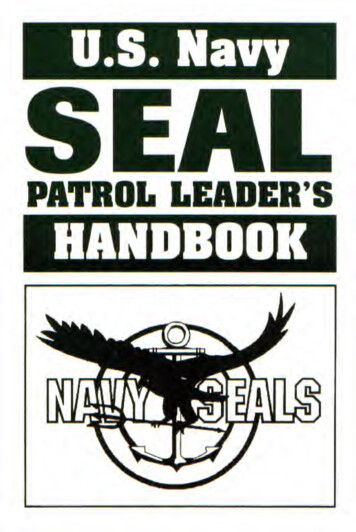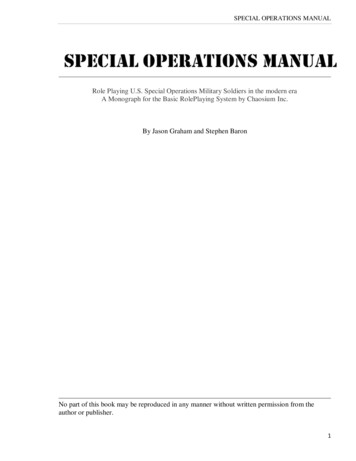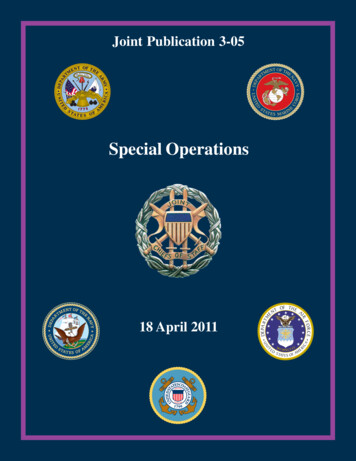
Transcription
Joint Publication 3-05Special Operations18 April 2011
PREFACE1. ScopeThis publication provides overarching doctrine for special operations and theemployment and support of special operations forces across the range of military operations.2. PurposeThis publication has been prepared under the direction of the Chairman of the JointChiefs of Staff. It sets forth joint doctrine to govern the activities and performance of theArmed Forces of the United States in joint operations and provides the doctrinal basis forinteragency coordination and for US military involvement in multinational operations. Itprovides military guidance for the exercise of authority by combatant commanders and otherjoint force commanders (JFCs) and prescribes joint doctrine for operations, education, andtraining. It provides military guidance for use by the Armed Forces in preparing theirappropriate plans. It is not the intent of this publication to restrict the authority of the JFCfrom organizing the force and executing the mission in a manner the JFC deems mostappropriate to ensure unity of effort in the accomplishment of the overall objective.3. Applicationa. Joint doctrine established in this publication apply to the Joint Staff, commanders ofcombatant commands, subordinate unified commands, joint task forces, subordinatecomponents of these commands, and the Services.b. The guidance in this publication is authoritative; as such, this doctrine will befollowed except when, in the judgment of the commander, exceptional circumstances dictateotherwise. If conflicts arise between the contents of this publication and the contents ofService publications, this publication will take precedence unless the Chairman of the JointChiefs of Staff, normally in coordination with the other members of the Joint Chiefs of Staff,has provided more current and specific guidance. Commanders of forces operating as part ofa multinational (alliance or coalition) military command should follow multinational doctrineand procedures ratified by the United States. For doctrine and procedures not ratified by theUnited States, commanders should evaluate and follow the multinational command’sdoctrine and procedures, where applicable and consistent with US law, regulations, anddoctrine.For the Chairman of the Joint Chiefs of Staff:WILLIAM E. GORTNEYVice Admiral, USNDirector, Joint Staffi
PrefaceIntentionally BlankiiJP 3-05
UNITED STATES SPECIAL OPERATIONS COMMANDOFFICE OF THE COMMANDER7701 TAMPA POINT BOULEVARDMACDILL AIR FORCE BASE, FLORIDA 33621-5323Joint Publication (JP) 3-05 Joint Special Operations is the culmination of a majorcollaborative effort within the joint community. This publication has captured our bestcharacterization yet of the functions, organization, employment, and synchronization ofSpecial Operations Forces (SOF).USSOCOM is responsible for the development of special operations doctrine asassigned in US Code, Title 10, and DoD Directive 5100.01. JP 3-05 and the five other jointpublications for which USSOCOM is designated as the lead agent are fundamental to thiseffort. USSOCOM is also developing SOF-specific doctrine, mirroring the responsibilitiesof the military departments to develop service-specific doctrine.Joint Special Operations doctrine provides the foundation for common understandingof key terms and concepts that help SOF work effectively with the joint force, partnernations, and other stakeholder agencies. While recognizing that no published doctrineexactly matches operational circumstances, this document is provided as a primary referenceto guide the Joint Force Commander’s employment of SOF.ERIC T. OLSONAdmiral, U.S. Navyiii
MemoIntentionally BlankivJP 3-05
SUMMARY OF CHANGESREVISION OF JOINT PUBLICATION 3-05, DATED 17 DECEMBER 2003 Subsumes sections of special operations and the principles of war, specialoperations and the principles of military operations other than war, and the natureof special operations into one discussion of special operations across the range ofmilitary operations. Discusses the following as part of command and control of special operations forces(SOF): SOF as the lead for a joint task force, integration and interoperability ofconventional forces and SOF, interorganizational coordination, and multinationalcoordination. Introduces the concept Special Operations Joint Task Force (SOJTF) throughwhich United States Special Operations Command will present all theater SOFunder one special operations commander. Incorporates a stand-alone section on geospatial information and services supportof SOF into a general discussion of support considerations. Adds sections on operational contract support, host-nation support, protection,maritime support, information operations support, and multinational support. Deletes an appendix on SOF education and training. Implements the change from the term “psychological operations” (PSYOP) to“military information support operations” (MISO). Revises and updates numerous definitions in accordance with current directivesand practice. Deletes discussion of SOF truths. Reflects the development of a United States Marine Corps SOF capability.v
Summary of ChangesIntentionally BlankviJP 3-05
TABLE OF CONTENTSPAGEEXECUTIVE SUMMARY . ixCHAPTER IOVERVIEW OF SPECIAL OPERATIONS Introduction. I-1Special Operations . I-1Special Operations Across the Range of Military Operations . I-2CHAPTER IISPECIAL OPERATIONS FORCES AND THEIR CORE ACTIVITIES Introduction.II-1Designated Special Operations Forces .II-1Characteristics of Special Operations Forces .II-2Special Operations Core Activities .II-5CHAPTER IIICOMMAND AND CONTROL OF SPECIAL OPERATIONS FORCES Introduction. III-1Assignment of Special Operations Forces . III-2Command and Control of Special Operations Forces in Theater . III-4Special Operations Forces as the Lead for a Joint Task Force . III-10Integration and Interoperability of Conventional Forces andSpecial Operations Forces . III-11Coordination and Liaison Elements. III-12Joint Special Operations Area . III-13Interorganizational Coordination . III-15Multinational Coordination . III-15CHAPTER IVSUPPORT CONSIDERATIONS FOR SPECIAL OPERATIONS FORCES Introduction. IV-1Intelligence Support . IV-1Operational Contract Support . IV-3Host-Nation Support . IV-4Logistic Support. IV-4Health Service Support . IV-5Communications Systems Support . IV-7Public Affairs Support . IV-8Combat Camera Support. IV-8Legal Support. IV-9vii
Table of Contents Protection . IV-9Fire Support . IV-10Air Support . IV-10Maritime Support . IV-10Space Support . IV-11Meteorological and Oceanographic Support . .IV-12Cyberspace Support . IV-13Information Operations Support . IV-13Multinational Support . IV-15APPENDIXABReferences . A-1Administrative Instructions .B-1GLOSSARYPart IPart IIAbbreviations and Acronyms . GL-1Terms and Definitions . IV-1IV-2IV-3viiiRange of Military Operations . I-3Five Special Operations Forces Mission Criteria .II-4Special Operations Core Activities .II-6Characteristics of Foreign Internal Defense .II-11Civil Affairs Operations Relationships .II-18Command and Control of Special Operations Forces in Theater. III-3Notional Joint Force Special Operations ComponentCommand and Control . III-5Notional Special Operations Forces Command and Control . III-8Notional Special Operations Liaison Element Functions . III-14Examples of Special Operations Forces Intelligence Requirements . IV-2Strategic Special Operations Forces Patient Movement . IV-7Space-Based Support to Special Operations Forces . IV-12JP 3-05
EXECUTIVE SUMMARYCOMMANDER’S OVERVIEW Provides an Overview of Joint Special Operations Describes Special Operations Forces and Their Core Activities Describes Command and Control of Joint Special Operations Discusses the Support of Joint Special OperationsOverview of Special OperationsUnited States SpecialOperations Commanddeploys and sustains specialoperations forces (SOF) tofacilitate operations withconventional forces (CF), topromote synergy among allSOF elements, and toprovide more efficientcommand and control (C2)structures.Special operations (SO) differ from conventionaloperations in degree of physical and political risk,operational techniques, modes of employment, anddependence on detailed operational intelligence andindigenous assets.SO are conducted in allenvironments, but are particularly well suited for deniedand politically sensitive environments. SO can betailored to achieve not only military objectives throughapplication of special operations forces (SOF)capabilities for which there are no broad conventionalforce requirements, but also to support the applicationof the diplomatic, informational, and economicinstruments of national power.Special Operations and Their Core ActivitiesDesignated SOFSOF are those forces identified in Title 10, UnitedStates Code (USC), Section 167 or those units or forcesthat have since been designated as SOF by Secretary ofDefense (SecDef). Generally, SOF are under thecombatant command (command authority) (COCOM)of the Commander, United States Special OperationsCommand (CDRUSSOCOM), or the respectivegeographic combatant commander (GCC) to which theyare assigned. SOF are those Active Component andReserve Component forces of the Services specificallyorganized, trained, and equipped to conduct and supportSO.Characteristics of SOFSOF are inherently joint. When employed, SOF arepresented with their command and control (C2)ix
Executive Summarystructure intact, which facilitates their integration intojoint force plans, retains cohesion, and provides acontrol mechanism to address SO specific concerns andcoordinate their activities with other components andsupporting commands.SOF are distinct from conventional forces (CF).Most SOF personnel undergo a careful selectionprocess and mission-specific training beyond basicmilitary skills to achieve entry-level SO skills.SOF Capabilities. SOF can be formed into versatile,self-contained teams that provide a joint forcecommander (JFC) with a flexible force capable ofoperating in ambiguous and swiftly changing scenarios.SOF are not a substitute for CF. In most cases SOFare neither trained, organized, nor equipped to conductsustained conventional combat operations and,therefore, should not be substituted for CF that are ableto effectively execute that mission.Most SO missions require non-SOF support.Five SOF Mission CriteriaIt must be an appropriate mission or activity for SOF.The mission or activities should support the JFC’scampaign or operation plan, or special activities.Mission or tasks must be operationally feasible,approved, and fully coordinated.Required resources must be available to execute andsupport the SOF mission.The expected outcome of the mission must justify therisks.Special Operations CoreActivitiesxSOF are specifically organized, trained, and equippedto accomplish the 11 core activities: direct action,special reconnaissance, counterproliferation of weaponsof mass destruction, counterterrorism, unconventionalwarfare, foreign internal defense, security forceassistance, counterinsurgency, information operations(IO), military information support operations (MISO),and civil affairs operations.JP 3-05
Executive SummaryCommand and Control of Special Operations ForcesC2 of SOF normally shouldbe executed within a SOFchain of command.SOF may be assigned to either CDRUSSOCOM or aGCC. The identification of a C2 organizationalstructure for SOF should depend upon specificobjectives, security requirements, and the operationalenvironment.LiaisonLiaison among all components of the joint force andSOF, however they are organized, is vital for effectiveSOF employment, as well as coordination,deconfliction, synchronization, and the prevention offratricide.SOF in the United StatesUnless otherwise directed by SecDef, all SOF based inthe continental United States are assigned to UnitedStates Special Operations Command (USSOCOM) andunder the COCOM of CDRUSSOCOM. USSOCOM isa unified command (Title 10, USC, Section 167) thathas the responsibilities of a functional combatantcommand and responsibilities similar to a MilitaryDepartment in areas unique to SO.SOF in TheaterSOF assigned to a GCC are under the COCOM of therespective GCC.A GCC normally exercisesoperational control of all assigned and attached SOFthrough the commander, theater special operationscommand (CDRTSOC) or a subordinate JFC. TheCDRTSOC also may be designated as the joint forcespecial operations component commander (JFSOCC)by the GCC.Theater Special OperationsCommandThe theater special operations command (TSOC) is theprimary theater SOF organization capable ofperforming broad continuous missions uniquely suitedto SOF capabilities. The TSOC is also the primarymechanism by which a GCC exercises C2 over SOF.SOF Operational C2The JFSOCC is the commander within a unifiedcommand, subordinate unified command, or joint taskforce (JTF) responsible to the establishing commanderfor making recommendations on the properemployment of assigned, attached, and/or madeavailable for tasking SOF and assets; planning andcoordinating SO; or accomplishing such operationalmissions as may be assigned. The JFSOCC is given thexi
Executive Summaryauthority necessary to accomplish missions and tasksassigned.A joint special operations task force (JSOTF) is aJTF composed of SO units from more than one Service,formed to carry out specific SO or prosecute SO insupport of a theater campaign or other operations. AJSOTF may have CF tasked to support the conduct ofspecific missions.SOF Subordinate C2 Organizations. A JSOTF, by itsjoint designation, has SOF from more than one of theServices: Army SOF, Navy SOF, Air Force SOF, orMarine Corps SOF, and these designations typicallydenote their forces and subordinate units, not aheadquarters.SOF as the Lead for a JointTask ForceSuch a construct calls for aSOF joint forcecommander, not as a jointforce special operationscomponent commander/commander joint specialoperations task force, but asthe commander, joint taskforce.In some cases, a C2 construct based on SO expertiseand influence may be better suited to the overallconduct of an operation (i.e., superiority in theaggregate of applicable capabilities, experience,specialized equipment, and knowledge of andrelationships with relevant populations), with the JTFbeing built around a core SO staff. Such a JTF has bothSOF and CF and the requisite ability to command andcontrol them. SOF and their unique capabilities areparticularly well-suited for such complex situationsbecause of their regional familiarity, language andcultural awareness, and understanding of the socialdynamics within and among the relevant populations(i.e., tribal politics, social networks, religiousinfluences, and customs and mores).Integration andInteroperability of CF hronizing of military operations in time, space, andpurpose; maximizes the capability of the joint force;allows the JFC to optimize the principles of jointoperations in planning and execution; and may producean operating tempo and battle rhythm with which theenemy is unable to cope. It may also reduce thepotential for fratricide. Accordingly, focus should beplaced on three key areas: operations, commandrelationships, and liaisons.Coordination and LiaisonElementsSOF commanders have specific elements that facilitateliaison and coordination. They include the specialxiiJP 3-05
Executive Summaryoperations command and control element (SOCCE) tocommand and control, and coordinate SOF activitieswith CF; the special operations liaison element (SOLE)to provide liaison to the joint force air componentcommander (JFACC) or appropriate Service componentair C2 facility; and SOF liaison officers placed in avariety of locations as necessary to coordinate,synchronize, and deconflict SO within the operationalarea.Joint Special OperationsAreaThe JFC may establish a joint special operationsarea (JSOA), which is a restricted area of land, sea,and airspace assigned by a JFC to the commander of ajoint SO force to conduct SO activities. When a JSOAis designated, the JFSOCC (or commander, joint specialoperations task force [CDRJSOTF]) is the supportedcommander within the designated JSOA.InterorganizationalCoordinationInteragency coordination is as integral to SO as it isconventional operations, and fostering personalrelationships between SOF commanders andinterorganizational leaders and professional relationsbetween both staffs should be a routine objective duringmilitary engagement activities.Multinational CoordinationSOF operate with multinational forces, i.e., forcesbelonging to a coalition or alliance, on a routine andrecurring basis. US SOF assess, train, advise, assist,and operate with a plethora of multinational foreign SOunits.Support Considerations for Special Operations ForcesSOF support must betailored to specific missionrequirements, yet flexibleenough to respond tochanging employmentparameters.The joint character of SO requires supportarrangements across Service lines with emphasis onunique support required in order to sustain independentand remote operations. Further, SOF must be able toexploit information derived from the full range ofavailable multinational, national, theater, and tacticalintelligence, surveillance, and reconnaissance supportsystems.Intelligence SupportAll-source, fused intelligence is vital in identifyingrelevant targets, course of action development, andmission planning/execution.SO require detailedxiii
Executive Summaryplanning, often by relatively small units. Consequently,intelligence requirements are normally greater in scopeand depth than that of CF. Joint intelligence preparationof the operational environment provides the foundationfor SO intelligence production.Operational ContractSupportThe continual introduction of high-tech equipment,coupled with force structure and manning limitations,and high operating tempo mean that SOF may beaugmented with contracted support, includingcontingency contractor employees and all tiers ofsubcontractor employees who are specificallyauthorized through their contract to accompany theforce and have protected status in accordance withinternational conventions (i.e., contractors authorized toaccompany the force).Host-Nation SupportHost-nation support (HNS) is that civil and/or militaryassistance rendered by a nation to foreign forces withinits territory based on agreements mutually concludedbetween nations. For SO, HNS must be weighedagainst operations security considerations, missionrequirements and duration, and the operationalenvironment.Logistic SupportGCCs and their Service component commanders, incoordination with the CDRTSOC, are responsible forensuring that effective and responsive support systemsare developed and provided for assigned/attached SOF.Health Service SupportSOF teams frequently operate in remote areas andtherefore, are exposed to health threats not normallyseen in the other areas of the respective host nations.Point-to-point movement to designated MedicalTreatment Facilities is standard while medicalregulating and strategic aeromedical evacuation mightbe required and should be part of the contingencyplanning process.Communications SystemsSupportCommunications systems support to SOF normally areglobal, secure, and jointly interoperable. It must beflexible so that it can be tailored to specific SOmissions and it must add value to the SOF operationalcapability.SOF must be able to communicateanywhere and anytime using the full range of nationalcapabilities required to support the mission.xivJP 3-05
Executive SummaryPublic Affairs SupportThe diplomatic and political sensitivity of many SOmandates that thorough and accurate public affairsguidance be developed during the operational planningstage and approved for use in advance of most SO.Combat Camera SupportCombat camera provides still and video documentaryproducts that support MISO and other SO missions.Many combat camera teams supporting SOF arespecially equipped with night vision and digital imagetransmission capabilities.Legal SupportSO missions frequently involve a unique set of complexissues. There are federal laws and executive orders,federal agency publications and directives, the law ofarmed conflict, and rules of engagement that may affectSO missions as well as the SO joint planning andtargeting processes.ProtectionProtection focuses on conserving the SOF fightingpotential, whether operating independently, or as part ofa larger joint force in a major operation/campaign. Forforce protection, typically each GCC has tacticalcontrol of US forces in their area of responsibility.Fire SupportSOF may require long-range, surface-based, joint firesupport in remote locations or for targets well beyondthe land, maritime, and amphibious operational forcearea of operations. SOF liaison elements coordinatefire support through both external and SOF channels.SOF liaison elements (e.g., SOCCE and SOLE) provideSOF expertise to coordinate, synchronize, anddeconflict SOF fire support.Air SupportIn addition to their organic air capabilities forinfiltration, exfiltration, resupply, and precision firesupport, SOF often require conventional air support thatrequires timely and detailed planning and coordination.Air support is typically provided by the JFACC (or anAir Force component commander), and theJFSOCC/CDRJSOTF normally provides a SOLE to theJFACC at the joint air operations center.Maritime SupportMaritime support is provided by the joint forcemaritime component commander, the Navy componentcommander, and/or the Marine Corps componentxv
Executive Summarycommander. Maritime support includes fire support,seabasing operations, deception, and deterrence.Space SupportSpace based support to SOF can include: unications, global intelligence collection,surveillance and warning, meteorological support,imagery for geospatial support and targeting, blue forcetracking data, and denying adversary use of space-basedcapabilities.Meteorological andOceanographic SupportThis [meteorological and oceanographic support]information can be used by the commander to choosethe best windows of opportunity to execute, support,and sustain specific SOF operations.Cyberspace SupportCyberspace operations in support of SO can often beconducted remotely, thus reducing the SOF footprintand contributing to freedom of action within a givenoperational area.Information OperationsSupportIO is a SOF core activity, and also integral to thesuccessful execution of many SO. SO may requiresupport from any combination of core, supporting, orrelated IO capabilities, so the JFC’s IO cell shouldinclude a SOF representative.Multinational SupportMultinational support to SOF complements HNS anddepends on mission and capability requirements.Common examples include information andintelligence sharing; providing liaison teams andsupport to planning efforts; materiel assistance; basing,access, and overflight permission; humanitarianassistance; and linguists and cultural advice andawareness.CONCLUSIONThis publication provides overarching doctrine for SOand the employment and support of SOF across therange of military operations.xviJP 3-05
CHAPTER IOVERVIEW OF SPECIAL OPERATIONS“Today we see a bewildering diversity of separatist wars, ethnic and religiousviolence, coups d’état, border disputes, civil upheavals, and terrorist attacks,pushing waves of poverty-stricken, war-ridden immigrants (and hordes of drugtraffickers as well) across national boundaries. In the increasingly wired globaleconomy, many of these seemingly small conflicts trigger strong secondary effectsin surrounding (and even distant) countries. Thus a “many small wars” scenario iscompelling military planners in many armies to look afresh at what they call“special operations” or “special forces”—the niche warriors of tomorrow.”Alvin and Heidi TofflerWar and Anti-War, Survival at the Dawn of the 21st Century 19931. IntroductionThis publication provides fundamental principles and guidance for the Services,combatant commanders (CCDRs), and subordinate joint force commanders (JFCs) to preparefor and conduct special operations (SO). It describes those military operations and providesgeneral guidance for military commanders to employ and execute command and control (C2)of special operations forces (SOF) assigned/attached to a geographic combatant commander(GCC), subordinate unified commander, or a commander, joint task force (CJTF). Otherspecific SO operational guidelines are provided in Joint Publication (JP) 3-05.1, JointSpecial Operations Task Force Operations; JP 3-13.2, Military Information SupportOperations, JP 3-22, Foreign Internal Defense, and JP 3-57, Civil-Military Operations.Additionally, SOF maintain core competencies in counterinsurgency (COIN) andcounterterrorism (CT) operations that are discussed in detail in JP 3-24, CounterinsurgencyOperations, and JP 3-26, Counterterrorism. This chapter introduces SO, the nature of SO,and how they relate to the principles of joint operations and the range of military operations.Chapter II, “Special Operations Forces and Their Core Activities,” focuses on the SOF andparticularly the 11 SOF core activities. Chapter III, “Command and Control of SpecialOperations Forces,” discusses C2 and coordination, and Chapter IV, “SupportConsiderations for Special Operations Forces,” outlines numerous support considerations forSOF.2. Special OperationsSO are conducted in all environments, but are particularly well suited for denied andpolitically sensitive environments. SO can be tailored to achieve not only military objectivesthrough application of SOF capabilities for which there are no broad conventional forcerequirements, but also to support the application of the diplomatic, informational, andeconomic instruments of national power. SO are typically low visibility or clandestineoperations. SO are applicable across the range of military operations. They can beconducted independently or in conjunction with operations of
UNITED STATES SPECIAL OPERATIONS COMMAND OFFICE OF THE COMMANDER 7701 TAMPA POINT BOULEVARD MACDILL AIR FORCE BASE, FLORIDA 33621-5323 iii Joint Publication (JP) 3-05 Joint Special Operations is the culmination of a major collaborative effort within the joint community.


